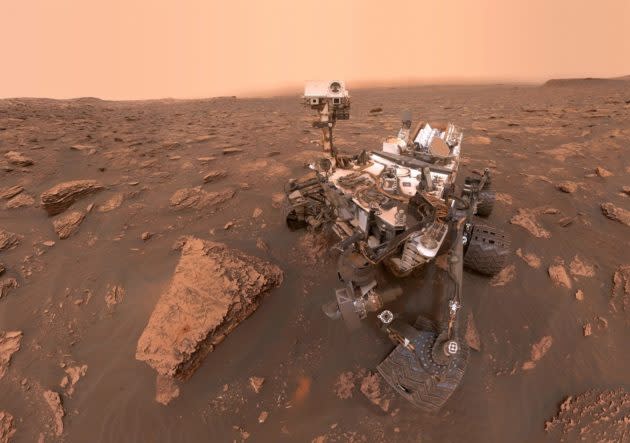Is there life on Mars, or on other worlds beyond Earth? The answer may be squishy

BELLEVUE, Wash. — NASA’s Curiosity rover has detected fresh whiffs of Martian methane, once again sparking speculation about a potential biological source — but researchers at the space agency say it’s too early to raise the alert for life on Mars.
Scientists who are gathering here for the annual Astrobiology Science Conference, or AbSciCon, acknowledge that depending on the context, methane could be an indicator of biological activity, as it is on Earth. But it could just as well be of purely geological origin.
“It’s not in itself a biosignature,” Abigail Allwood, a field geologist at NASA’s Jet Propulsion Laboratory, told GeekWire today during a media workshop.
The belch of methane detected last week is intriguing nevertheless — in that it’s the highest level detected during Curiosity’s nearly seven years of operation on Mars. The concentration amounted to about 21 parts per billion units by volume, or three times as strong as a detection that created a scientific hubbub back in 2013.
Scientists correlated that earlier spike with measurements taken from orbit by the European Space Agency’s Mars Express probe, and said the best explanation was that seismic activity triggered a release from reservoirs of methane trapped beneath Mars’ surface.
NASA said Curiosity’s scientists would make further observations to gather more data about the newly reported release, and compare their results with readings taken by ESA’s Trace Gas Orbiter. That probe’s sensitive spectrometers should be able to sniff out methane in the Martian atmosphere, but it hasn’t recorded a single whiff in the past year.
“Combining observations from the surface and from orbit could help scientists locate sources of the gas on the planet and understand how long it lasts in the Martian atmosphere,” NASA said today in a statement. “That might explain why the Trace Gas Orbiter’s and Curiosity’s methane observations have been so different.”
Experts say they’re not likely to find a smoking gun — or, for that matter, a tribe of flatulent aliens — as they search for evidence of ancient or extant life on Mars. That caveat applies as well to ice-covered worlds with hidden oceans, such as the Jovian moon Europa and the Saturnian moon Enceladus.
It’s more likely that the evidence for life beyond Earth will accumulate slowly, from multiple threads of inquiry. Those threads could include, say, the abundances of specific isotopes, or the lengths and complexity of organic molecules, or a preference for left-handedness or right-handedness in amino acids or sugars.
Several scientists at the Bellevue meeting discussed the idea of creating a standard instrument suite that could detect life in a variety of settings, like the Star Trek tricorder that Spock carried. “Hopefully, a pentacorder of a heptacorder,” said Chris German, a senior scientist at the Woods Hole Oceanographic Institution.
Sarah Stewart Johnson, a planetary scientist at Georgetown University, said answers to questions about extraterrestrial life won’t be 100 percent yes or no, at least af first. Rather, they’ll take on more complicated statistical forms.
“We’re trying to move away from this binary ‘This Is Life / This Is Not Life’ … but really change the approach into something like ‘this is 3-sigma away from what we would expect from abiotic processes,’ ” she said.
Mary Voytek, who’s in charge of NASA’s Astrobiology Program, introduced a new term — “credu-probability” — to describe the significance of a biosignature. “How credible is it, and what’s the probability that it represents life?” she said.
Toward that end, astrobiologists will be unveiling the latest iteration of their “Ladder of Life Detection” assessment system this week: The “Life Detection Forum” won’t be a mathematical formula like the Drake Equation, or a rating system like the Torino Scale for asteroid threats. Instead, it’ll be a Web-based platform where astrobiologists can fine-tune their approaches to the life-detection question.
“The most important aspect of this is to get real, and get rigorous,” Voytek said.
Such a process should help researchers put the proper perspective on findings like last week’s methane detection — and follow the scent.
“That’s the next step … figure out where it’s coming from,” Allwood said. “And if you want to, go and send a mission there. See what’s producing it.”
More from GeekWire:
That burst of Martian methane is long gone, but mystery of life on Mars remains
NASA’s Curiosity rover tracks down organic molecules and methane on Mars
Sweet! Scientists narrow down source of mysterious burst of methane on Mars
Europe’s Trace Gas Orbiter sends its first color picture of Mars – and it’s spectacular